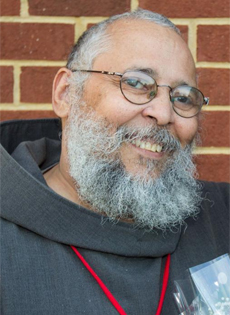
For Catholics and non-Catholics
Gospel ‘Cliffs Notes’ on the rosary
Monday, October 16, 2017
* Br. Jay RIVERA FFV
For Catholics, the month of October is the Month of the Holy Rosary. Let’s clarify. It’s not the only time of year when Catholics pray the rosary. October has been designated as the Month of the Holy Rosary because, on the 13th of October, Our Lady of the Rosary appeared for the last time at Fatima. It was on this day that thousands of people gathered at that town in Portugal saw what has been called The Miracle of Sun.
Many of our non-Catholic friends believe that praying the rosary is evil, because “one should not pray to saints, because only God is to be worshiped.”
Let’s clarify the first point. When Catholics pray the rosary, we are not worshiping the Blessed Mother. And because this is aimed at refuting those objections, all my citations will come from the King James Version of the Bible.
Those who are familiar with the Gospel of Luke should be able to recognize these words: “And the angel came in unto her, and said, ‘Hail, thou that art highly favoured, the Lord is with thee: blessed art thou among women’.” (Lk 1:28)
During the rosary, we pray the Hail Mary 53 times. Pay close attention to the opening lines of the prayer: “Hail Mary, full of Grace. The Lord is with thee. Blessed are thou amongst women.”
We’re speaking to Mary with the words of the Angel Gabriel. Who would dare say that Gabriel’s words are blasphemy or idolatry? Was Gabriel worshipping Mary?
Absolutely not. He is greeting her and in the greeting, he acknowledges that Mary has a special place in God’s mind. Catholics refer to this as “grace.” Instead of saying “favored of the Lord” we simply say, “full of grace.” After all, can one be favored by the Lord and be devoid of his life (grace)?
Then the angel informs Mary that her relative, Elizabeth, is in the sixth month of her pregnancy. Mary sets out to the town where Elizabeth lived. One can safely assume that it was to lend a hand, since Elizabeth was an older woman. Luke tells us: “And it came to pass, that, when Elisabeth heard the salutation of Mary, the babe leaped in her womb; and Elisabeth was filled with the Holy Ghost: And she spoke out with a loud voice, and said, ‘Blessed art thou among women, and blessed is the fruit of thy womb’.” (Lk 1:41-42)
The Hail Mary continues with the words of Elizabeth: “Blessed are thou amongst women, And blessed is the fruit of thy womb, Jesus.” At this point, we insert the Holy Name of Jesus as a reminder that it is the Son of God who is the fruit of Mary’s womb. We speak to the Virgin Mary using the words of Sacred Scripture.
Elizabeth continues: “And whence is this to me, that the mother of my Lord should come to me?” (Lk 1:43)
Gabriel had said this of Mary’s son: “And, behold, thou shalt conceive in thy womb, and bring forth a son, and shalt call his name Jesus. He shall be great, and shall be called the Son of the Highest: and the Lord God shall give unto him the throne of his father David: And he shall reign over the house of Jacob forever; and of his kingdom there shall be no end.” (Lk 1:32-33)
Gabriel and Elizabeth refer to Jesus as God. Elizabeth uses “the mother of my Lord.” The Jewish people recognized only one Lord. That was God. Elizabeth addresses Mary as the Mother of God. The angel informs Mary that her son will reign forever and that he is the Son of the Highest.
Neither Gabriel nor Elizabeth are stating the Mary is the mother of the Trinity (Father, Son and Holy Ghost). She is the mother of the Son. The question is simple. Do you believe that Jesus Christ is God? Do you acknowledge that Mary of Nazareth is Jesus’ mother? Does this make her the mother of 1/3 of God? No. She is the mother of one of the three persons in God. All three persons are the one God. That’s why we can refer to her as “the Mother of God.”
And so, Catholics pray: “Holy Mary, Mother of God.”
Observe the closing statement in the Hail Mary: “Pray for us, sinners. Now and at the hour of our death.”
Is there anything wrong with asking another person to pray for us today and at the hour of our death? Some may say that Mary cannot pray for us, because she is dead. But didn’t Jesus promise eternal life to those who are faithful? “And, behold, there appeared unto them Moses and Elias talking with him…” (Mt 17:3)
Moses and Elias (Elijah) had been dead several hundred years. Yet they appear and speak with Jesus. The disciples who are watching observe that they are real, not ghosts. It’s not too difficult to believe that if Moses and Elias could be seen by the disciples, even though they had been dead for several centuries, and that Jesus could converse with them, why should we not believe that Jesus’ mother is not granted the same or a higher privilege than Moses and Elias?
Jesus is the perfect son. He would place his mother in stasis while allowing the prophets and patriarchs to live after death? Jesus is not cruel. We can safely conclude that Mary can pray for us, because she’s alive.
During the rosary, we pray the Hail Marys in sets of 10. Each recitation of the rosary has five sets of 10. The Psalms were originally divided into sets of 10. Each set of psalms followed a theme. So it is with the rosary. Five decades and each decade offers us a reflection on one of the mysteries in the life of Christ and his relationship to God the Father, the Holy Spirit, and to his mother. Christ would not leave her out of his circle of significant others.
The Father and the Holy Spirit or Holy Ghost are the same God as Jesus. It’s obvious that any event in Jesus’ life is going to involve the Father and the Holy Ghost, front stage or back stage. But they are present. Because Jesus is human, as well as divine, he has another significant person in his life, just like us. That person is his mother. She is not part of the Trinity. She is not God. But she is the Mother of one of the three persons in God. We believe that Jesus is God.
“Then Simon Peter answered him, Lord, to whom shall we go? Thou hast the words of eternal life. And we believe and are sure that thou art that Christ, the Son of the living God.” (Jn 6:68-69)
Peter makes a public profession of faith. He identifies Jesus as the Christ or the Anointed One who is both God and Son of God.
This Christ has a mother, who is not God. She is very much a human being. As she is the mother of the perfect son, it stands to reason that the Father would not select a sinful woman to carry His son in her womb to be contaminated by sin. Remember, Jesus has a human nature. God the Father creates the sinless woman to be the God Bearer.
In conclusion: The rosary has five decades. We recite the Hail Mary using the words found in the Bible. Catholics did not make this up. We are not worshiping Mary.
In the first half of the Hail Mary, we are praising her, just as Gabriel and Elizabeth praised her. Who would accuse Gabriel or Elizabeth of worshiping Mary? The second part of the rosary is a petition. We ask Mary to pray for us.
There is nothing wrong with asking someone to pray for us. If I have an opportunity to ask the mother of the King to put in a good word with her son, on my behalf, I would be a fool not to take advantage of the same.


Comments from readers